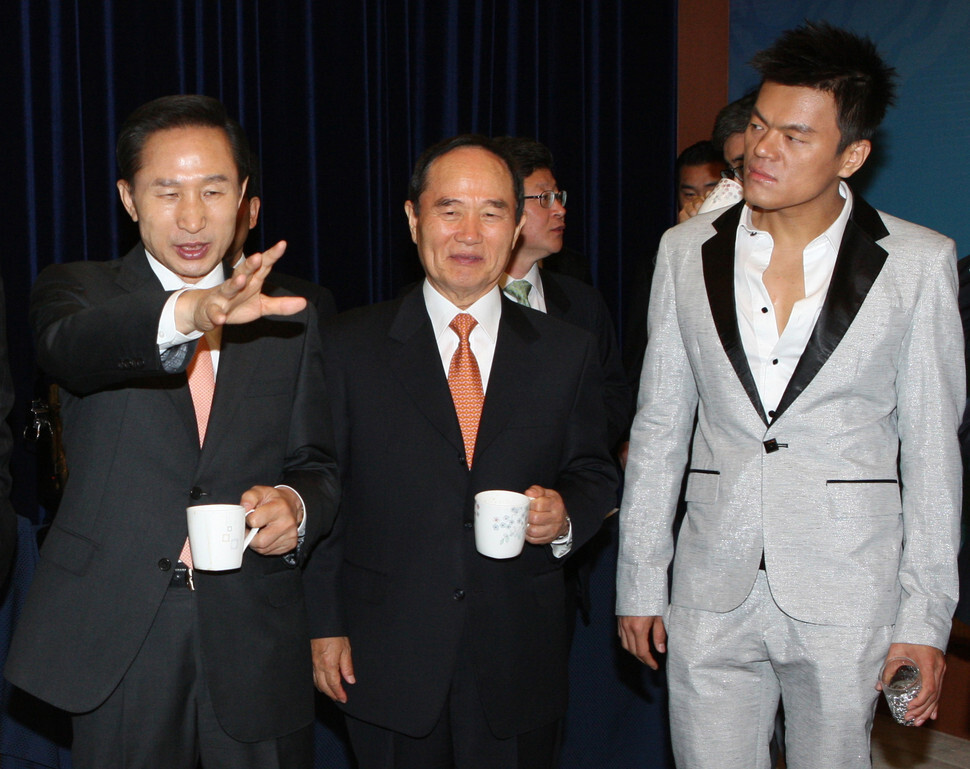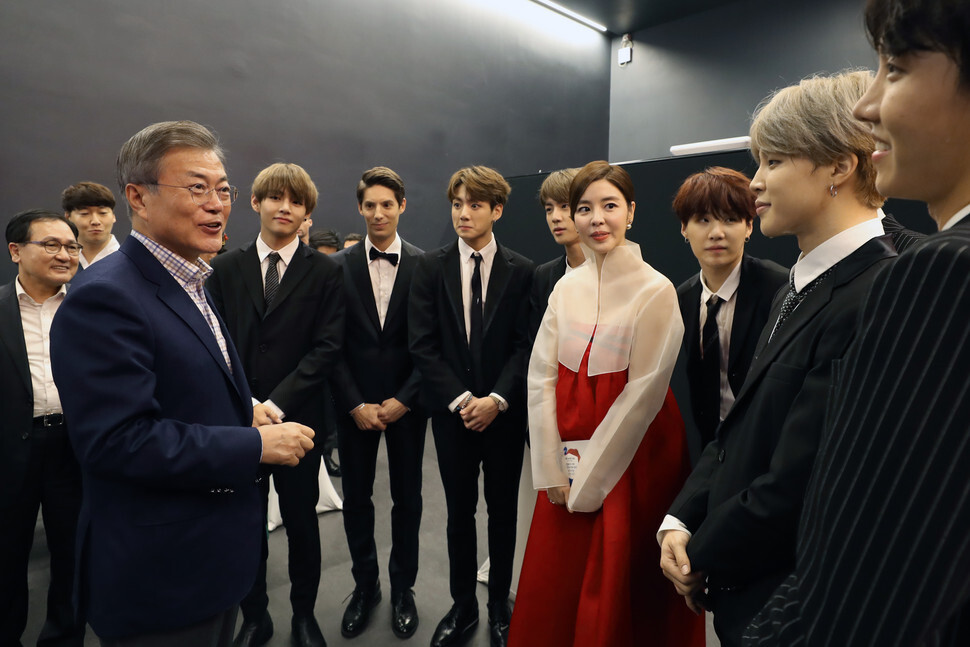hankyoreh
Links to other country sites 다른 나라 사이트 링크
[News analysis] The Revival of the government’s “K-promotion” brand strategy
As 2020 begins, the letter “K” has started appearing again in the South Korean government’s economic policy directions. “K-content,” “K-beauty,” and “K-food” have been lumped together into the so-called “3K” areas. Plans to hold two “K-culture festivals” a year in conjunction with this are also being emphasized. The focus of consumption measures is once again falling on the Korea Sale Festa, which is being tied in with 3K. A “K-promotion” brand strategy is being developed to support the overseas expansion of smaller businesses. The list of policies is a veritable flurry of “K”s.

Since President Moon Jae-in took office, consumption measures have consisted largely of efforts to expand incomes and support leisure activities by South Koreans. SME measurements have generally been focused on building “fair ecosystems.” It is a bit of a surprise, then, to see the flood of “K”s appearing in the administration’s consumption and SME measures. Was there some particular reason behind this? Ko Gwang-hee, a Ministry of Economy and Finance general policy department chief, insisted, “There isn’t some particular motivation behind this. ‘3K’ is the current trend, and we wanted to tie it to the promotion of the economy.” The situation has also drawn little attention. The Moon has simply been cautious about mentioning it, but the use of “K” terms and phrases like “Korean Wave” and “Korea brand” have been recited like mantras for close to three decades. The letter “K” -- something that people have felt awkward talking about despite its obvious importance, a prefix that holds little meaning either to the presenter or to the reader -- popped up 34 times in the 2020 economic policy direction.
The year was 1994. Seo Taiji and Boys were singing “Enough, enough, enough” (“Classroom Idea”). The culture seemed to be laying waste to authoritarianism. It was also the year President Kim Young-won called for “nurturing a high value-added culture industry and boosting international competitiveness by dressing ordinary industry items in ‘cultural clothes’” during a January presidential progress report. Globalization, belief in markets, and “soft nationalism” were now taking the place of the waning authoritarianism -- a “first-class nation” achieved through culture.
The goal was not unique to South Korea. A concept of “soft nationalism,” which involved building national strength through culture, also appeared in Japan during the early 1990s. (Won Yong-jin, “Korean Wave Policy and Soft Nationalism”) In the UK, the Tony Blair administration declared a “Cool Britannia” campaign, expanding the culture industry in areas such as design, music, and software to the national level to take the place of fading manufacturing. (Kim Eo-jin, “Political Economics of the Creative Economy”) Culture was now an industry; it was an important moment in terms of establishing national identity in an age of globalization. There were some seeds of a debate over whether the cultural values of diversity, naturalness, and autonomy were really suited with industrialization or nationalism. It wasn’t discussed much.
Fast-forward to the late 1990s/early 2000s. “I think I was 12 years old when Clon came to Taiwan. Korean music wasn’t really popular yet, so I thought they were quite cool,” said Liu Ching-wei, now a 35-year-old employee at a Taipei software company. For Liu, the Korean Wave of “a really long time ago” was something cool, a way to set oneself apart. Liu bought albums by S.E.S. and H.O.T. By the early ’00s, “My Sassy Girl” became a hit and “everyone was now watching and singing Korean Wave hits,” he explained. Many of Liu’s responses in his Facebook Messenger interview with the Hankyoreh 21 contained ellipses that hinted at some embarrassment while talking about the era.
Liu’s interest gradually cooled. The “new thing” quickly became the popular thing, and similar images and stories appeared over and over according to the same popular success strategy.
“I think it may be that it’s only that kind of popular culture that is being presented as the ‘Korean Wave’ in Taiwan,” he said. “But I lost interest seeing all of those similar singles and TV series. I was also turned off by the overall ‘Korea is the greatest’ attitude. It may just be my personal taste.”

In 2001, the South Korean government finally began including the term “Korean Wave” in systematic state-level projects by way of its “Culture Industry Vision 21” and subsequent “Korean Wave industry support and development plan.” The film “My Sassy Girl” and the miniseries “Winter Sonata” became big hits. But the unexpected overseas response also raised a hint of concern. In a 2018 “Korean Wave and Cultural Policy” interview, film director and former Minister of Culture Lee Chang-dong recalled, “After H.O.T. performed in China in 2000, it had an enormous impact on the local community. That shock quickly led into a form of wariness about South Korean culture, and South Korean performances were subsequently banned outright. [. . .] Things had to proceed in a way that was about feeling and sharing together without stepping on anyone’s toes or injuring their pride.”
Around 2008, the term “content industry” began taking the place of “culture industry.” As with manufacturing before it, the state channeled resources into supporting the industry amid a climate that emphasized “generating results.” From academia, critical voices began to chime in. In “The Korean Wave Policy as a Corporate State Project under the Lee Myung-bak administration,” Choi Young-hwa writes, “Whereas [past administrations] pursued a minimal public service character for culture as a cultural policy philosophy, [the Lee administration] would reduce culture to a ‘content product’ and pursue an explicitly corporate model of marketing strategy, including the ‘branding’ of the country to promote exports of specific cultural products, i.e., Korean Wave content.”
Under the Park Geun-hye administration’s “Creative Economy” approach, the scope of “K-content” was broadened to encompass all areas of society, including food, education, and sports. In the process, issues concerning the pursuit of personal gains began to surface (including corruption in the establishment of the K-Sports Foundation), and Park’s presidency came to an ignominious end. For a time afterward, the “K” label was no longer given pride of place in government economic policies. The Moon Jae-in administration’s governance tasks merely included a focus on a “friendly Korean Wave,” with an emphasis on “bidirectional communication” and “fairness in the culture industry.”
The year is now 2020. The results of the Korean Wave are undeniable. About half of it comes thanks to the gaming industry, but cultural content exports totaled US$7.5 billion for 2018, surpassing the US$7.22 billion total for home appliances, another area that used to be a source of pride for South Korea. (Export-Import Bank of Korea, “Economic Effects of Korean Wave Cultural Content Exports”) But difficult questions remain about things that cannot be reduced to numbers.
“There’s a certain line that exists,” said Won Yong-jin, a professor at Sogang University. “When you’re stressing the ‘national brand,’ you can’t let it come across too much like a national plan, and while industrial value is important, you can’t let it look like you’re focusing mostly on the industry aspect. You have to constantly be on guard.”
Similar concerns can also be glimpsed in a National Assembly Budget Office assessment of Korean Wave budget projects included in the economic policy direction. In its “2020 Budget Analysis,” the NABO wrote, “In view of the negativity that is being expressed over aggressive expansion of the Korean Wave and an excessive industry focus amid the emphasis on being a ‘Korean Wave growth country,’ some discussion appears to be needed on the appropriateness and effectiveness of government-led Korean Wave expansion policies.”

What does Liu Ching-wei think about the Korean Wave-based tourism promotion and export measures?
“They could have an effect,” he predicted. “I’m not especially excited, though.”
He went on to say something a bit unexpected, which reflected his thoughts about the essence of society and culture.
“People don’t see Korean pop culture as ‘natural,’” he said. “The South Korea we see in the news looks excessively competitive and doesn’t seem like a happy place. There are only the identically packaged images [of happiness] in the Korean Wave.”
“Naturalness and diversity are important parts of culture, and it feels like society needs to become more candidate and more tolerant of diversity for that to happen,” he added.
A South Korean culture that naturally radiates the kind of societal mature that cannot simply be packaged through “planning” -- as a member of the first-generation of Korean Wave consumers, Liu is posing questions that go beyond Korean Wave product to consider South Korea’s potential as a society.
By Bang Jun-ho, staff reporter
Please direct comments or questions to [english@hani.co.kr]

Editorial・opinion
![[Column] Park Geun-hye déjà vu in Yoon Suk-yeol [Column] Park Geun-hye déjà vu in Yoon Suk-yeol](https://flexible.img.hani.co.kr/flexible/normal/500/300/imgdb/original/2024/0424/651713945113788.jpg) [Column] Park Geun-hye déjà vu in Yoon Suk-yeol
[Column] Park Geun-hye déjà vu in Yoon Suk-yeol![[Editorial] New weight of N. Korea’s nuclear threats makes dialogue all the more urgent [Editorial] New weight of N. Korea’s nuclear threats makes dialogue all the more urgent](https://flexible.img.hani.co.kr/flexible/normal/500/300/imgdb/original/2024/0424/7317139454662664.jpg) [Editorial] New weight of N. Korea’s nuclear threats makes dialogue all the more urgent
[Editorial] New weight of N. Korea’s nuclear threats makes dialogue all the more urgent- [Guest essay] The real reason Korea’s new right wants to dub Rhee a founding father
- [Column] ‘Choson’: Is it time we start referring to N. Korea in its own terms?
- [Editorial] Japan’s rewriting of history with Korea has gone too far
- [Column] The president’s questionable capacity for dialogue
- [Column] Are chaebol firms just pizza pies for families to divvy up as they please?
- [Column] Has Korea, too, crossed the Rubicon on China?
- [Correspondent’s column] In Japan’s alliance with US, echoes of its past alliances with UK
- [Editorial] Does Yoon think the Korean public is wrong?
Most viewed articles
- 1‘We must say no’: Seoul defense chief on Korean, USFK involvement in hypothetical Taiwan crisis
- 2N. Korean delegation’s trip to Iran shows how Pyongyang is leveraging ties with Moscow
- 3Amnesty notes ‘erosion’ of freedom of expression in Korea in annual human rights report
- 4[Column] Park Geun-hye déjà vu in Yoon Suk-yeol
- 5‘Weddingflation’ breaks the bank for Korean couples-to-be
- 6[Reportage] On US campuses, student risk arrest as they call for divestment from Israel
- 7[Editorial] New weight of N. Korea’s nuclear threats makes dialogue all the more urgent
- 8Korea sees more deaths than births for 52nd consecutive month in February
- 9Will NewJeans end up collateral damage in internal feud at K-pop juggernaut Hybe?
- 10Why Korea shouldn’t welcome Japan’s newly beefed up defense cooperation with US